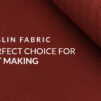
As the world becomes increasingly conscious of the environmental impact of the textile industry, sustainable and eco-friendly fabrics are becoming more popular. Undoubtedly, One such fabric that has been gaining the attention of the people in recent years is linen fabric.
Linen is a natural fabric created from flax plant fibers that have been used for thousands of years.
Linen was once a luxury fabric, prized for its softness, durability, and ability to keep the wearer cool in hot weather. Today, linen is still valued for those same qualities, but it is also becoming popular for its eco-friendliness and sustainability.
Read on the blog to know why linen is a sustainable fabric of the future.

Why is linen considered a great fabric? Reasons!
One of the main reasons linen is considered a sustainable fabric is because of the way it is produced. Flax is a hardy plant that needs fewer pesticides and water than other crops like cotton. Also, it is naturally resistant to pests, which means fewer chemicals are required for its growth. Additionally, flax is often grown in cooler climates where rain is more abundant, meaning irrigation is not necessary.
The production process for linen is also relatively low-impact. After the flax is harvested, the fibers are separated from the rest of the plant through a process called retting. This can be done using water or chemicals, but water retting is the most eco-friendly option as it does not produce any harmful byproducts. The fibers are subsequently spun into yarn, which is ultimately woven into cloth.
Also, Linen is a highly durable fabric that can last for years if cared for properly. It is naturally resistant to bacteria, mildew, and moths, and can withstand high temperatures and frequent washing without losing its shape or quality. This means that linen garments and household items like bedding and towels can be used and enjoyed for a long time, reducing the need for replacements and therefore reducing waste.
Few more reasons why linen is an ideal fabric!
In addition to its sustainability and durability, linen has several other eco-friendly qualities. For example, it is biodegradable, meaning it will break down naturally over time and not contribute to the ever-growing problem of textile waste. It also has a low carbon footprint, as the production process requires relatively little energy and does not produce significant greenhouse gas emissions.
Linen is also a versatile fabric that can be used in a variety of ways. It is commonly used for clothing like shirts, dresses, and trousers, but it is also popular for household items like bedding, towels, and tablecloths.
If you are looking for high quality linen for fabric, consider Sew Banana linen fabric.
Despite its many benefits, linen does have some drawbacks. One of the main challenges with linen is that it tends to wrinkle easily, which can be frustrating for some people. However, this is also part of the fabric’s charm, as the wrinkles give it a casual, relaxed look. Some people also find linen to be somewhat stiff and uncomfortable at first, but with wear and washing, it becomes softer and more comfortable. Another potential issue with linen is that it can be expensive compared to other fabrics. This is because the production process is more labor-intensive than other fabrics, and the demand for linen is currently higher than the supply. However, as more consumers seek out sustainable and eco-friendly fabrics, the cost of linen may become more competitive.

Few final thoughts
Overall, linen is a fantastic eco-friendly and sustainable fabric that has a lot of potential for the future. As consumers become more aware of the environmental impact of the textile industry and seek out alternatives to fast fashion, linen is likely to become even more popular. With its durability, versatility, and unique look and feel, linen is a fabric that can be enjoyed and appreciated for years to come. You can shop this versatile fabric from Sew Banana fabric collection.






